Appropriate Rural Technology Institute (ARTI)
2nd Floor Maninee Apartments, Survey No.13, Dhayarigaon / Pune / Maharashtra / 411 041 India
Short Description
- Problem: Cooking fuel, waste disposal, inefficiency of traditional biogas cattle dung digesters
- Idea:A very efficient process of biomethanisation thanks to high calorie content of the waste used for the bacteriological digestion. The system is usable by any household.
- Difficulty:Construction: easy to medium, use: easy. The digester should be kept at temperatures between 32 & 37°C (89.6-98.6°F)
- Material Needed: 2 plastic water tanks, one of 1cubic meter, the other of 0,75 cubic meter content, flexible pipe, stable horizontal base, frame to stop the gas tank rise, inlet and outlet fittings
- Geographic Area: Global, in temperate to cold climates, the plant has to be heated
- Competencies: Simple plumbing skills
- How Many people? 2
- How Long does it take? From three to max. ten hours construction time, two weeks to start the methan production
Glossary
Biomethanisation: occurs through the anaerobic digestion of organic material by bacteria. The bacteria digest the calories contained in the organic material and release methane and carbon dioxide.
Feedstock: organic material that will be fed regularly into the digester to be digested into methane.
Slurry: mixture of decomposing feedstock and water.
Comparaison with existing systems
The current process of biomethanisation, which uses feedstocks like: cattle dung, human faeces, distillery effluents etc is highly inefficient because the nutritionally available calories and nutritive value of these substances is quite low, as the calories present in the food have already been used by the cattle, humans or fermentation processes.
Common sense says that the energy output of a system must matched with the input.
Methane has a calorific value of 11000 kcal/kg. To obtain such a high energy output, the methanisation process should receive a correspondingly high calorific input.
Nowadays, municipal solid waste (MSW) is also being used as a source of methane. Food rests in the MSW have a relatively high caloric content, but in the current process, called the two phase fermentation system, the waste is first subject to an aerobic fermentation in order to reduce its bulk, and only then, having very few calories left in it, being fed to the anaerobic methane digesters.
Such traditional biogas production systems operating on human or animal faeces or with the two-phase fermentation system produce approximatively 10 kg of methane per tonne of feedstock in a process completed in 40 days. The duration can be shortened using thermophilic bacterias but the input to output ratio remains unchanged.
Further, the use of cattle dung as the feedstock for methanisation is a main factor limiting the widespread use of domestic methane plants in India for the supply for household fuel: -the present domestic biogas plant requires 40kg cattle dung per day, ( from 6 to 8 heads of cattle) -because the dung has a retention time of 40 days, the size of the plant is large -the servicing of the plant requires the daily mixing of the dung with water to make it feedstock, filling it into the biogas plant and the disposal of about 80 to 100 liters of effluent slurry, which is a source of complain from the users. Restrictions of space, money, insufficient animals to feed the plant and maintenance problems stop many farmers and households from this technology.
ARTI New Biogas technology
ARTI developed in 2003 a new Biogas technology which uses high calorie feedstock, consisting of starchy or sugary material. This high calorie content in the material allows to produce 250 kg of methane per tonne of feedstock (on dry weight basis) in a process time of one day.
Which means that a household needing methane to cook 3 meals a day will need to feed its domestic plant with 2 kg of material per day. The material used can be so varied as: waste grain, seed of any plant species, oilcake of non edible oilseeds, non edible or non marketable fruits ( wild species of ficus, overripe mangos and bananas…) food rests, oil rests, even the flour swept from the floor of a flour mill can be used as feedstock for the biogas plant.
Because of the small quantities and the speed of the process, size, maintenance and price are drastically reduced:
-The gas holder of the plant has a capacity of 750 to 1000 litres which is enough to cook two meals for a family of 5.
-the user feeds daily the digester with one kilo mashed feedstock mixed with some water in the morning and one kg in the evening,
-the total daily effluent produced by this system is 10 litres, that can be watered to the garden plants or recycled in the digester.
-the new biogas plant ranges between Rs. 10000 and Rs. 15000 corresponding to the price of two in another fitting plastic water tanks, a concrete base and the necessary frame and plumbing ware.
How to build the new compact biogas plant:

The apparatus itself consists of:
-Two plastic water tanks sold in sanitary and plumbing ware shops. One should be bigger than the other so that once the top of each tank is cut open, the smaller one can fit in the bigger one and move like a “telescope“. The bigger tank (or drum) serves as a digester, and the smaller, placed upside down in the bigger one serves as the gas holder.
-The inlet pipe: a 3cm diameter flexible pipe, a bit longer than the height of the tank, is fitted at the bottom side of the bigger tank. At the free extremity of the pipe , a funnel is fixed to facilitate the pouring of the quite fluid feedstock material. The pipe with the funnel are to be fixed loosely to the top of the tank, in upright position. This pipe will also serve as a purge in case of necessity.
-The effluent outlet is fitted to the upper part of the bigger tank and determines the maximum level of matter in the tank.
-The gas outlet is fitted to the smaller inner tank and directed toward a gas stove.
-a frame structure is build above the tanks to stop the gas tank to fall open when too filled. It is possible to put a weight on the upper tank to increase gas pressure in the tank.
Methane burns with a blue flame, without producing any smoke or soot. It is therefore an environmentally friendly cooking system. Thus, introduction of the new efficient, compact biogas system would not only help urban households in utilizing their domestic wet waste, but also help prevent millions of premature deaths of women and children in rural households due to indoor air pollution caused by smoke and soot from burning fuelwood in traditional chulhas. This markedly impacts the health of the people in the kitchen (mainly women) positively. Further reductions in pollution and energy use arise from not having to transport LPG cylinders to be re-filled. The small amount of solid residue produced by the biogas plant makes a good fertiliser. Methan, on the contrary of propane, is lighter than air, there is therefore little risk of an accumulation and explosion in case of a leak. In hot regions, the system could be placed in a garden or on an accessible roof terrasse, for it needs a relatively warm temperature.
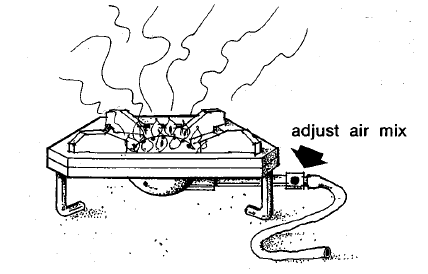
Adjust the air input to the burner so that the flamme is blue and not yellow.
How to start the process?
The system is first loaded with a slurry of about 20 kg of cattle dung, waste flour or starch and water.: The bacteria present in the intestine and consequently in the dung of the cattle are the bacteria that will break down the organic material into methane and carbon dioxide. After a waiting time of about 2 weeks, the gas should start to be emitted and the upper tank will raise. Test the gas by burning it: if it is combustible, you can start adding high calorie material.
Feedstock: daily 1 kg to 1,5 kg mashed feedstock mixed with 10 to 15 litres water in the morning and the same in the evening.
The feed can be waste flour, vegetable residues, waste food, waste oil, fruit peelings and rotten fruit. Oil cake, left over from oil-pressing, is another useful feedstock. Even rhizomes of banana, canna, nutgrass, non-edible seeds (e.g. Leucaena, Sesbania, tamarind, mango kernels) and spoilt grain serve as excellent feedstock material. Feedstock with large lumps (more than 20 mm) should be broken up with a food blender. Hand and pedal powered food blenders are being developed, for when electricity is not available.
The digester should provides a steady supply of gas, typically 250 g of gas per day from 1 kg (dry matter) of feed.
Is it possible to use the compact biogas system in urban environments?
The compact biogas plant technology developed by ARTI readily accepts highly digestible organic materials such kitchen waste as feedstock and can easily blend into the urban lifestyle. A single plant produces sufficient biogas to at least halve the use of LPG or kerosene for cooking in a household, as well as a small amount of solid residue which can be used as fertiliser. ARTI’s compact biogas plant could be replicated anywhere where there is the space for the plant, and the temperature is sufficiently high.
In villages, food waste was traditionally fed to animals or left by the side of the road for animals to devour. People continue to do this in cities but there are fewer animals to consume it. The result is that smelly, rotting food attracts flies and rats. This new biodigestor technology offers a solution not just for domestic waste disposal, but also for collective disposal of community waste.
What kind of problems can occure?
A biogas plant can become acidic and fail if it is over-fed, and this is a particular challenge with a plant using highly digestible organic materials. If this happens, the plant can be recovered by ceasing feeding and then building up the feed rate slowly. This problem was more common with the early smaller systems (0.5 or 0.75 m3) than with the later, larger systems.
Safety
Futher, there are important safety rules to consider: Like water, electricity, automobiles and most of life biogas is not completely safe, but by being aware of the dangers involved you are well on the way to a safe and happy digestion experience.
FIRE/EXPLOSION
Methane, which is makes up from 0% to 80% of biogas, forms explosive mixtures in air!
The lower explosive limit being 5% methane and the upper limit 15% methane. Biogas mixtures containing more than 50 % methane are combustible, while lower percentages may support, or fuel, combustion. With this in mind no naked flames should be used in the vicinity of a digester and electrical equipment must be of suitable quality, normally “explosion proof”. Other sources of sparks are any iron or steel tools or other items, power tools (particularly comutators and brushes), normal electrical switches, mobile phones and static electricity.
If conducting a flamability test take a small sample well away from the main digester, or incorporate a flame trap in the supply line, which must be of suitable length (minimum 20 m). View sketches of Flametrap1 and Flametrap2, functionning with water levels
As biogas displaces air it reduces the oxygen level, restricting respiration, so any digester area needs to be well ventilated to minimise the risks of fire/explosion and asphyxiation.
DISEASE
As Anaerobic Digestion relys on a mixed population of bacteria of largely unknown origin, but often including animal wastes, to carry out the waste treatment process care should be taken to avoid contact with the digester contents and to wash thoroughly after working around the digester (and particularly before eating or drinking). This also helps to minimise the spread odours which may accompany the digestion process. The digestion process does reduce the number of pathogenic (disease causing) bacteria, particularly at higher operating temperatures, but the biological nature of the process needs to be kept in mind.
ASPHYXIATION
Biogas consists mainly of CH4 and CO2, with low levels of H2S and other gases. Each of these components has its own problems, as well as displacing oxygen.
- CH4 – lighter than air (will collect in roof spaces etc), explosive (see above).
- CO2 – heavier than air (will collect in sumps etc), slightly elevated levels affect respiration rate, higher levels displace oxygen as well.
- H2S – (rotten egg gas) destroys olefactory (smelling) tissues and lungs, becomes odourless as the level increases to dangerous and fatal. More details, an actual case and detection equipment are available at www.adelaide.edu.au/biogas/safety/.
Adequate ventilation, suitable precautions and adequate protective equipment will minimise the dangers associated with biogas, making it a good servant rather than a bad master.
If you feel like experimenting…
Basically, as the bacterias present in the intestine and consequently in the dung of the cattle are the bacterias that will break down the organic material in methane and carbon dioxid, as a consequence, anything that the cattle is able to digest will be producing methane. Maybe are there other bacterias, present in the intestine of other animals, that would be able to digest other types of organic material: let’s think about insects for exemple? it is said that american scientists are experimenting with termites to breack down lignous material in methan. The bacterias develop when the proper feedstock is available, so crushing a few termites in the slurry might increase the methan production with poor calory material.
How to purchase the ARTI compact biogas system? Cost & Payment
Samuchit Enviro-Tech (SET) Pvt. Ltd., a company set up by members of ARTI, is in charge of commercialising the ARTI compact biogas system. ARTI’s trained technicians install the biogas plants using locally available plastic tanks (commonly used for water storage) and a plumbing kit supplied by SET. SET also supplies a single burned biogas stove made of cast iron, and a gas cock. This set, consisting of the plumbing kit and a single burner biogas stove, costs Rs. 2350 (M.R.P. inclusive of taxes and transport anywhere in India). The total estimated cost of the compact biogas system for a typical household (around 1000-1500 lit capacity) is about Rs.10,000, but the actual cost may vary based on local prices of plastic tanks and local labour costs.
Alternative Designs
A model with 2 (cleaned!)oil drums
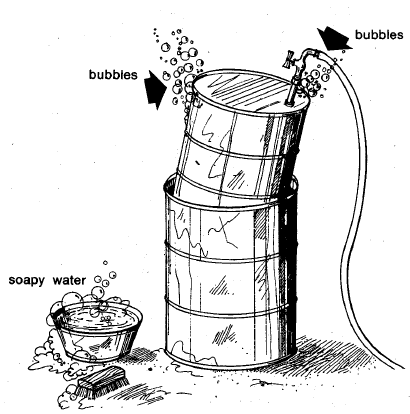
(You can check for leaks by using soapy water.)
An improved model with a gas chamber
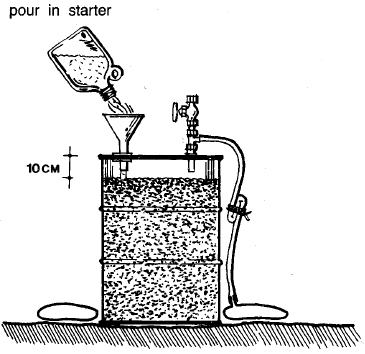

A large drum model
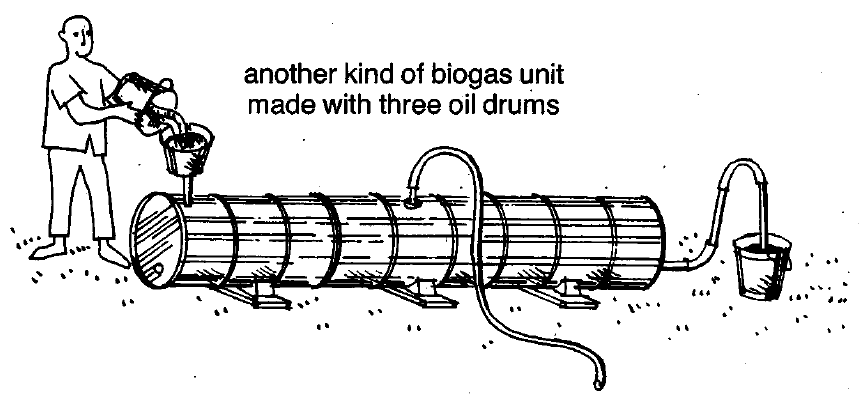
A small home model
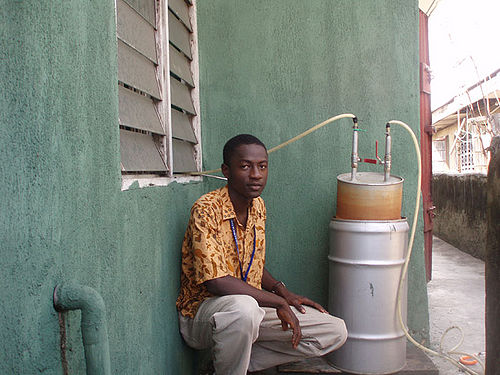
Contacts
Appropriate Rural Technology Institute (ARTI)
2nd Floor Maninee Apartments, Survey No.13, Dhayarigaon / Pune / Maharashtra / 411 041 India
arti_pune@vsnl.net
00 91-20-24390348 / 24392284
00 91-20-24390348
Installation and technical support: Samuchit Enviro-Tech Pvt. Ltd.
Flat No. 6, Ekta Park Co-op Hsg Society, Behind Nirmitee Showroom / Law College Road, Erandwana / Pune – 411004.
Tel. and Fax: 020-25460138
Email: samuchit@vsnl.net
Average maximum biogas production from different feed stocks
|
Sl. No.
|
Feed Stock
|
Litre /kg of dry matter
|
% Methane content
|
|
1.
|
Dung
|
350*
|
60
|
|
2.
|
Night-soil
|
400
|
65
|
|
3.
|
Poultry manure
|
440
|
65
|
|
4.
|
Dry leaf
|
450
|
44
|
|
5.
|
Sugar cane Trash
|
750
|
45
|
|
6.
|
Maize straw
|
800
|
46
|
|
7.
|
Straw Powder
|
930
|
46
|
Average gas production from dung may be taken as 40 lit/kg. of fresh dung when no temperature control is provided in the plant. One Cu. m gas is equivalent to 1000 litres.
Average dung yield
|
Sl. No.
|
Living Beings
|
Quantity of Dung / Night Soil produced (kg/day)
|
|
1.
|
Cow, Heifer |
10.0
|
|
2.
|
Bullock |
14.0
|
|
3.
|
Buffalo |
15.0
|
|
4.
|
Young bovine |
5.0
|
|
5.
|
Horse |
14.0
|
|
6.
|
Horse, young |
6.0
|
|
7.
|
Pigs, over 8 score |
2.5
|
|
8.
|
Pigs, under 8 score |
1.0
|
|
9.
|
Ewes, rams and goats |
1.0
|
|
11.
|
Lambs |
0.5
|
|
12.
|
Duck |
0.1
|
|
13.
|
10 hens |
0.4
|
|
14.
|
Human beings |
0.4
|
Note :For free grazing animals the availability of dung may be taken as 50 per cent of the amount given in the table
Requirement of cattle for various sizes of biogas plants
|
Plant Size in m 3
|
Minimum number of
cattle required |
|
2
|
3
|
|
3
|
4
|
|
4
|
6
|
|
6
|
10
|
|
8
|
15
|
|
25
|
45
|
Carbon to Nitrogen Ratio of various materials
|
Sl. No.
|
Material
|
Nitrogen Content (%)
|
Ratio of Carbon to Nitrogen
|
|
1.
|
Urine
|
15.18
|
8:1
|
|
2.
|
Cow dung
|
1.7
|
25:1
|
|
3.
|
Poultry manure
|
6.3
|
N.A.*
|
|
4.
|
Night soil
|
5.5-6.5
|
8:1
|
|
5.
|
Grass
|
4.0
|
12:1
|
|
6.
|
Sheep waste
|
3.75
|
N.A. *
|
|
7.
|
Mustard straw
|
1.5
|
20:1
|
|
8.
|
Potato tops
|
1.5
|
25:1
|
|
9.
|
Wheat straw
|
0.3
|
128:1
|
* N.A.:- Data Not Available
Calorific values of commonly used fuels
|
Commonly used fuels
|
Calorific values in Kilo calories
|
Thermal efficiency
|
|
Bio-gas
|
4713/M3
|
60%
|
|
Dung cake
|
2093/Kg
|
11%
|
|
Firewood
|
4978/Kg
|
17.3%
|
|
Diesel (HSD)
|
10550/Kg
|
66%
|
|
Kerosene
|
10850/Kg
|
50%
|
|
Petrol
|
11100/Kg
|
—
|
Equivalent quantity of fuel for 1 m3 of biogas
| Name of the fuel | Kerosene | Fire-wood | Cowdung cakes | Charcoal | Soft coke | Butane | Furnace Oil | Coal gas | Electricity |
| Equivalent quantities to 1 m3 of Bio-gas | 0.620 | 3.474 kg | 12.296 kg | 1.458 kg | 1.605 kg | 0.433 kg | 0.4171 | 1.177 m3 | 4.698 kWh |
Biogas Requirements
| Sl. No. | Use | Quantity requirement |
|
1.
|
Cooking | 336 – 430 1/ day / person |
|
2.
|
Gas Stove | 330 1/ hr /5 cm burner |
| 470 1/hr/10 cm burner | ||
| 640 1/hr/15 cm burner | ||
|
3.
|
Burner Gas Lamp | 126 1/lamp of lighting equivalent to 100 watt filament lamp. |
| 70 1/hr/1 mantle lamp | ||
| 140 1/hr/2 mantle lamp | ||
| 1691/lir/3 mantle lamp | ||
|
4.
|
Dual fuel engine | 425 1/hp/hr |
Abhiramgamango rayagada GP rayagada back rayagada Ditsti gajapati odisha pin 761213